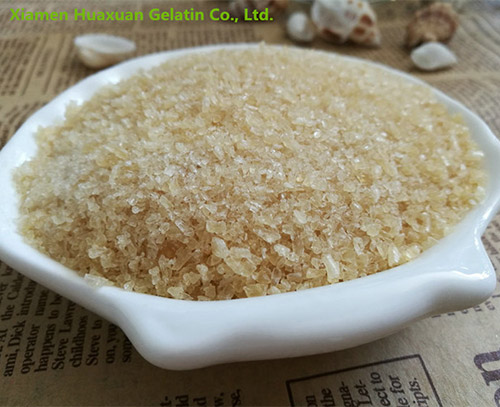
Animal glue, also known as industrial gelatin, skin glue, is the main component of adhesive.
It is a protein solid made from the partial hydrolysis, extraction and drying of collagen contained in animal skin, bone or tendon. Color is light yellow to brown.
It can soluble in water, slightly soluble in alcohol, insoluble in organic solvents. Its aqueous solution has surface activity and high viscosity.
When cooled, it will freeze into an elastic gel and returns to a solution when heated.
The latter is unique to animal gelatins and can be quantified in terms of gel strength, often referred to as freezing capacity.
This is the main physical property that determines the commercial value of animal gelatins, the rigidity of gels formed under standard conditions.
The value of commodities increases as the freezing force increases. The freezing force is measured by a special instrument called a luminance meter, expressed in grams.
| Item | Unit | Standard date |
| Jelly strength | Bloom/g | ≥100 |
| Viscosity | °E | ≥5 |
| Moisture | % | ≤16 |
| Ash | % | 10 |

Animal glue can be divided into bone glue and skin glue according to raw materials. Broadly speaking, animal glue also includes blood glue, fish glue, cheese glue, tortoise shell glue, etc., but these products are not large in scale, not widely used, so generally not included in the classification of animal glue.
If according to the refined level of the product cent, the coarse taste of rough processing is bone glue and skin glue, fine taste of fine processing is gelatin. If according to the product is divided into gelatin and industrial glue (bone glue and leather glue) two categories. Food grade gelatin is more versatile than bone glue and skin glue. Food grade gelatin is the main product of most modern animal glue manufacturers. Traditionally, bone glue, skin glue and gelatin are collectively called three glue.
The production process of hide glue mainly includes raw material pretreatment, extraction and finished product manufacturing.
(4) Drying: using drum dryer or long net belt dryer. Roller type is clearance type operation, suitable for small and medium-sized enterprises. Long net belt type is continuous operation, suitable for large factories. After drying, the water content of the product is generally less than 16%. Some products need to be crushed and screened after drying to get the final product.
First use the same amount or slightly more water (the general glue ratio is 1 to 1.2-3, it is best to use warm water) to soak the glue for a few hours, let it soften, then heat it up to about 75 degrees, so it can be used as glue.
The proportion of glue should be determined according to the viscosity needed, such as lower viscosity is had when adding too much water, higher viscosity is had when adding too small water. The temperature should not be too high when heating glue, the temperature exceeding 100 degrees will due to molecular degradation and viscosity decrease, glue aging deterioration.
The glue has trace precipitation in the process of use, so it is necessary to add water to the stirring side to adjust the viscosity and fluidity. Hot glue must be heated by bath heat method, do not directly use glue storage container heating. Glue can only be used under certain temperature conditions, therefore: when adding water while using, water temperature should be basically the same as the glue temperature, do not add cold water. Because the glue must be kept at a certain temperature (75 degrees ±10 degrees), the temperature will drop sharply after adding cold water, which will cause clumps and affect the bonding effect. When using glue, the speed of glue coating should be fast and uniform. Do not dip the glue too much at a time to cause uneven rubber layer, infiltration, joint adhesion, glue leakage and other problems. Adjust the amount of water and rubber powder to the required viscosity, coating use.
In short, animal glue or industrial gelatin is widely used in plate, furniture, matches, feed, packaging, paper making, textile, silk, printing and dyeing, printing, ceramics, petroleum, chemical, coating, metallurgy and other industries of all kinds of products, including the main thickening, stabilization, coagulation, blending, polishing, sizing, solid glue, etc.
There are many types of gelatin. beef gelatin, gelatin powder & leaf gelatin.
Our wholesale gelatin is slightly yellow to yellow, transparent or translucent microstrip luster flakes or powder
In the food industry, edible gelatin is used as an additive in confectionery. Gelatin candy.
Gelatin have many usage. Gelatin have edible gelatin, industrial gelatin
XIAMEN HUAXUAN GELATIN CO.,LTD have started to supply gelatin granule and hard empty capsule to different countries from 2006.
© 2025 hx-gelatin.com. All Rights Reserved.
Rihua building, Huli District, Xiamen, Fujian, CN.

Scan on our Wechat / Scan on our Whatsapp
